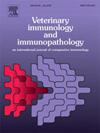探索犬过敏与健康中的 CD4 +CD8 + 双阳性 T 细胞:试点研究
IF 1.4
3区 农林科学
Q4 IMMUNOLOGY
引用次数: 0
摘要
cd4 +CD8 + 双阳性(DP) T细胞在健康和患病的人和狗的外周血中都有少量存在。在人类中,这些细胞根据疾病的不同发挥细胞毒性或抑制作用,但它们在狗身上的功能尚不清楚。本研究旨在研究DP T细胞在食物不良反应(AFR)犬群中的存在,比较其在AFR、非食物性特应性皮炎(NFICAD)和健康犬(HTY)中的频率,并评估DP T细胞是否可以作为区分AFR和NFICAD的诊断工具,并识别AFR犬的罪魁祸首过敏原。方法采集AFR、NFICAD和健康对照犬的外周血。分离pbmc并通过流式细胞术分析以评估T细胞亚群。根据其特定的罪魁祸首过敏原对AFR犬进行分组,并比较各组之间DP T细胞对每种过敏原的反应。比较三组(AFR, NFICAD, HTY)在刺激和非刺激条件下DP T细胞的增殖情况。健康犬中增殖的DP T细胞的平均百分比被用作与口服食物攻击(OFC)结果相关的截止值。结果dp T细胞在各组均有增殖,其中AFR组在食物过敏原刺激下增殖最多。AFR组和NFICAD组之间的差异有统计学意义,AFR组的狗表现出更多的增殖。在28.57 %的病例中,该测试确定了罪魁祸首过敏原,17.86 %的病例出现假阳性。结论与NFICAD等其他过敏性疾病相比,食物过敏犬的dp T细胞增殖更大。尽管存在这些差异,但重叠的结果表明,DP T细胞并不是区分过敏犬与健康犬的可靠筛选试验。虽然该测试具有识别过敏表型的潜力,但它在确定特定过敏原方面缺乏足够的诊断价值。未来的研究需要更大的样本量和更完善的方法来提高诊断的准确性。本文章由计算机程序翻译,如有差异,请以英文原文为准。
Exploring CD4 +CD8 + double-positive T cells in canine allergy and health: A pilot study
Background
CD4 +CD8 + double-positive (DP) T cells are present in low numbers in the peripheral blood of both healthy and sick humans and dogs. In humans, these cells play cytotoxic or suppressive roles depending on the disease, but their function in dogs remains unclear.
Objectives
This study aims to investigate the presence of DP T cells in a cohort of dogs with adverse food reactions (AFR), compare their frequency among AFR, non-food-induced atopic dermatitis (NFICAD), and healthy dogs (HTY), and evaluate whether DP T cells could serve as a diagnostic tool to differentiate between AFR and NFICAD and identify the culprit allergens in AFR dogs.
Methods
Peripheral blood samples were collected from dogs with AFR, NFICAD, and healthy controls. PBMCs were isolated and analyzed by flow cytometry to assess T cell subpopulations. AFR dogs were grouped by their specific culprit allergens, and DP T cell proliferation in response to each allergen was compared across groups. An overall comparison of DP T cell proliferation was made between the three groups (AFR, NFICAD, HTY) under both stimulated and non-stimulated conditions. The mean percentage of proliferating DP T cells in healthy dogs was used as a cut-off to correlate with oral food challenge (OFC) results.
Results
DP T cells proliferated in all groups, with the greatest proliferation observed in the AFR group when stimulated with food allergens. Statistically significant differences were found between AFR and NFICAD groups, with AFR dogs showing more proliferation. The test identified the culprit allergens in 28.57 % of cases, with false positives occurring in 17.86 %.
Conclusions
DP T cells showed greater proliferation in food-allergic dogs compared to those with other allergic conditions like NFICAD. Despite these differences, overlapping results indicate that DP T cells are not a reliable screening test for distinguishing allergic from healthy dogs. While the test holds potential for identifying allergic phenotypes, it lacks sufficient diagnostic value for pinpointing specific allergens. Future studies with larger sample sizes and refined methods are needed to improve diagnostic accuracy.
求助全文
通过发布文献求助,成功后即可免费获取论文全文。
去求助
来源期刊
CiteScore
3.40
自引率
5.60%
发文量
79
审稿时长
70 days
期刊介绍:
The journal reports basic, comparative and clinical immunology as they pertain to the animal species designated here: livestock, poultry, and fish species that are major food animals and companion animals such as cats, dogs, horses and camels, and wildlife species that act as reservoirs for food, companion or human infectious diseases, or as models for human disease.
Rodent models of infectious diseases that are of importance in the animal species indicated above,when the disease requires a level of containment that is not readily available for larger animal experimentation (ABSL3), will be considered. Papers on rabbits, lizards, guinea pigs, badgers, armadillos, elephants, antelope, and buffalo will be reviewed if the research advances our fundamental understanding of immunology, or if they act as a reservoir of infectious disease for the primary animal species designated above, or for humans. Manuscripts employing other species will be reviewed if justified as fitting into the categories above.
The following topics are appropriate: biology of cells and mechanisms of the immune system, immunochemistry, immunodeficiencies, immunodiagnosis, immunogenetics, immunopathology, immunology of infectious disease and tumors, immunoprophylaxis including vaccine development and delivery, immunological aspects of pregnancy including passive immunity, autoimmuity, neuroimmunology, and transplanatation immunology. Manuscripts that describe new genes and development of tools such as monoclonal antibodies are also of interest when part of a larger biological study. Studies employing extracts or constituents (plant extracts, feed additives or microbiome) must be sufficiently defined to be reproduced in other laboratories and also provide evidence for possible mechanisms and not simply show an effect on the immune system.

 求助内容:
求助内容: 应助结果提醒方式:
应助结果提醒方式:


